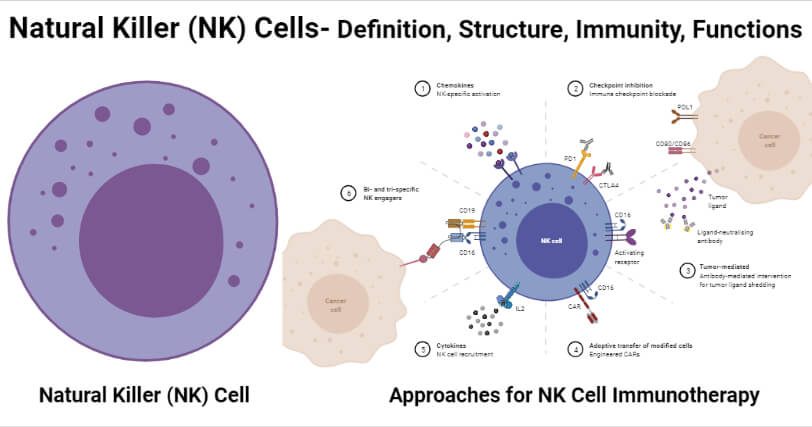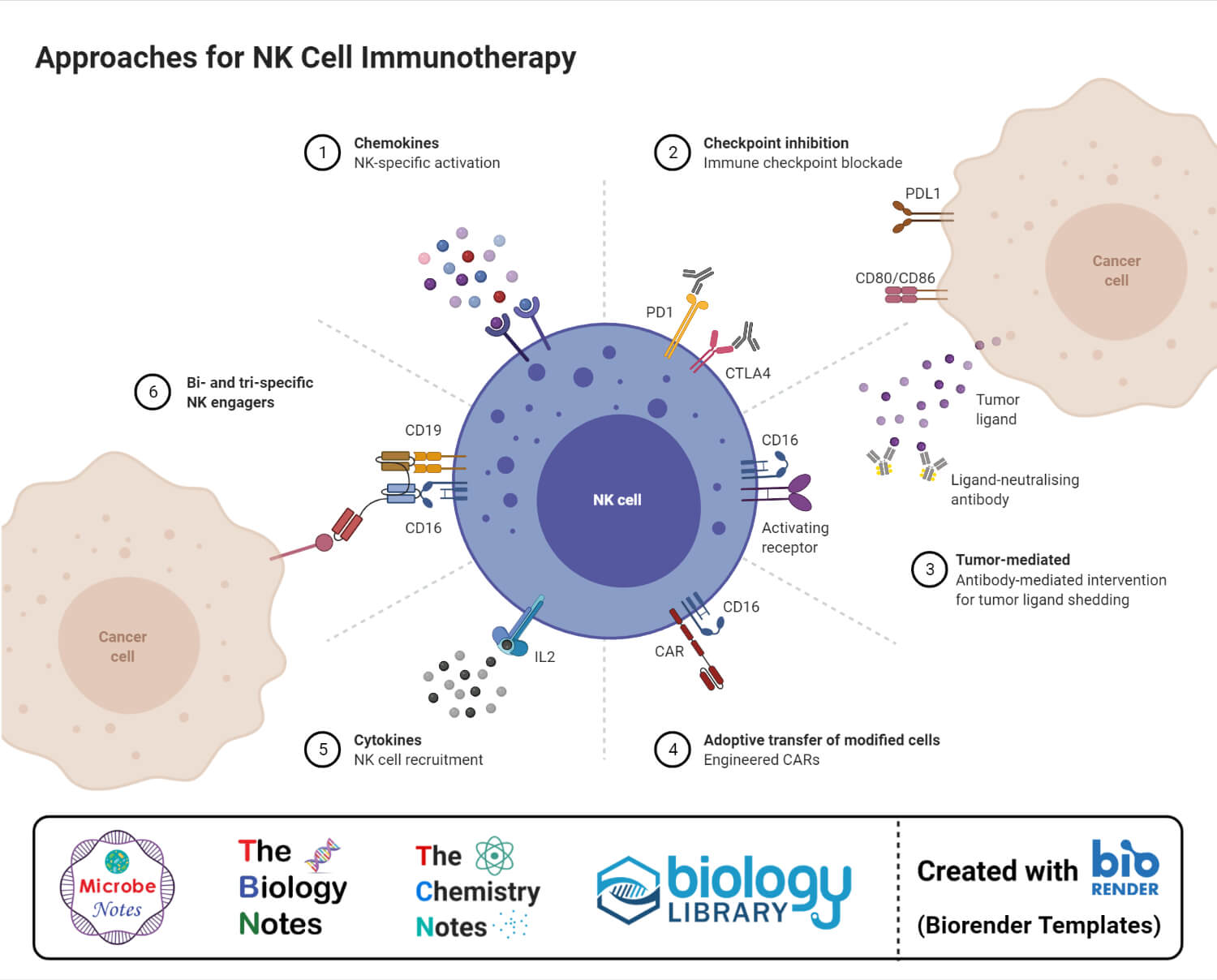Interesting Science Videos
What are Natural Killer (NK) Cells?
Definition of NK Cells
Natural killer (NK) cells are a group of innate lymphocyte cells with cytolytic activity against virus-infected cells and physiologically stressed cells like tumor cells.
- Initially, NK cells were described as larger granular lymphocytes with cytotoxic activity against tumor cells. However, these have since been recognized as a separated lineage of lymphocytes with cytotoxicity as well as cytokine-producing effector functions.
- Natural killer cells are a part of the group consisting of other lymphoid cells like B and T lymphocytes. NK cells can be differentiated from these lymphocytes in that they express a limited set of receptors that are activated by damage caused by other cells.
- The name natural killer cells derived from the fact that these cells can target cells without the need for prior activation.
- These cells are essential for the management of immunological responses as well as for innate immunity. NK cells secrete cytokines like interferon-γ, TNF-α, chemokines, and other factors that modulate the functions of other immune cells.
- Natural killer cells are one of the rapidly dividing families of lymphoid cells that represent about 5-20% of all the circulating lymphocytes in the blood.
- Natural killer cells were traditionally thought to develop exclusively in the bone marrow; however, more recent studies have demonstrated that these can develop and mature in secondary lymphoid tissues like the spleen and tonsils.
- Natural killer cells can be found in the skin, uterus, kidney, joints, gut, liver, and breast under normal physiological conditions.
- These cells account for 20-30% of the total hepatic lymphocytes and 10% of lymphocytes found in the human liver and lung.
- The development of NK cells progresses through various stages of maturation, expansion, and acquisition of receptors.

Structure of Natural Killer (NK) Cells
- Natural killer cells are large, granular, and bone-marrow-derived lymphocytes. The granules found in the cytoplasm of the cell are azurophilic and are filled with hydrolytic and digestive enzymes.
- NK cells are larger in diameter than other similar lymphocytes. These lack the receptors found in other lymphocytes like T and B cells.
- These cells account for about 5% of the peripheral circulating lymphocytes and can be observed on Wright-Giemsa-staining.
- Natural Killer cells also exist in various shapes and express microvilli, especially in the area of effector-to-target contact.
- The granules in these cells consist of two distinct compartments. The outer compartment consists of the lysosome-associated phosphatase acid enzymes and trumetaphosphatase.
- The inner compartment consists of structural components and has no enzymatic activities associated with it.
- During degranulation, a particular area within the cytoplasm forms multiple vacuole-like areas consisting of granules and some granular debris.
- The cytoplasm also contains other cytoplasmic organelles like mitochondria and polysomes.
- The nucleus is convoluted with distinct polarity against dense granules and pseudopodia.
- The surface of natural killer cells consists of different activating and inhibitory receptors that recognize different membrane proteins.
How do NK Cells work against pathogens? (Immunity)
The immune response of NK cells against pathogens or other antigens can be differentiated into different categories;
1. Cytotoxic Immune Response
- The cytotoxic response of NK cells can be described in four distinct steps. The process is called degranulation which leads to the release of cytotoxic molecules like perforin and granzyme.
- During the process, proteins like lysosomal-associated membrane protein-1 and -2 (LAMP-1 and LAMP-2) are expressed on the surface of the NK cells.
- The perforin released in the target cells polymerizes and forms pores on them, facilitating the entry of granzymes into the target cells.
- Granzymes are serine proteases that can activate caspase molecules resulting in the induction of apoptosis of the target cells.
The four steps of degranulation can be described as below:
- Formation of immunological synapse between the target cell and NK cell followed by a reorganization of the actin cytoskeleton.
- Polarization of microtubule-organizing center and secretory lysosome towards lytic synapse.
- Docking of secretory lysosome with the plasma membrane of NK cells.
- Fusion of secretory lysosome with the plasma membrane of target cells.
- The cytotoxic activity of NK cells can also be described by another process that involves death receptor-induced target cell apoptosis.
- During this process, NK cells express TNF receptor ligands that bind to their corresponding receptors on the target cells.
- The binding of the death receptors to the cognate ligand induces a conformational change in the receptor and the activation of adaptor proteins responsible for the apoptosis of the target cells.

2. Effector Immune Response of NK cells
- The effector immune response of NK cells is due to the release of various cytokines like IFN-γ, TNF-α, IL-10, IL-5, and IL-13, as well as chemokines like IL-8 and MIP-1β.
- These compounds are released by activated NK cells, which then play an essential role in antiviral, antibacterial, and antitumor activity.
- The IFN-γ is responsible for the modulation of caspase, FasL, and TRAIL expression, which in turn activates antitumor activity.
- The activation of IL-8 promotes regression of melanoma tumors by inhibiting tumor metastasis in a perforin-dependent manner.
- Thus, the cytotoxic immune response of NK cells is boosted by the cytokines secreted by other immune cells as well as stromal cells in the tumor microenvironment.
3. Inhibitory action
- In order to prevent the potential killing of normal cells of the body, NK cells also express a different inhibitory receptor that recognizes membrane proteins on normal cells and inhibit NK-mediated cytotoxic killing of these cells.
- NK cells thus are a part of our innate sensing mechanisms to provide an appropriate response and eliminate autoimmunity.
Functions of Natural Killer (NK) Cells
The following are some of the functions of NK cells;
- Cytolytic activity of NK cells is one of the most important responses of NK cells against antigens. The activity is mediated by granules found in the cytoplasm of the lymphocytes.
- Natural killer cells are also involved in antibody-dependent cell-mediated cytotoxicity, where antibodies bound to antigens are recognized by specific receptors present on NK cells.
- NK cells can be activated by cytokines released by stressed cells as a result of viral infection. The activated NK cells with activated cytotoxic T cells activate macrophages for phagocytosis.
- NK cells usually lack antigen-specific cell surface receptors, which enable them to react with antigens immediately without any prior exposure.
- These cells are essential for the immunosurveillance of tumor cells as these can directly induce death of tumor cells even in the absence of surface adhesion molecules and antigenic molecules.
- Natural killer cells with other cells of the innate immune system, like macrophages, work to clear dead and senescent cells.
- Even though NK cells are considered cells of the innate immune system, recent studies have revealed that NK cells display different adaptive features like the expansion of subsets, increased longevity, and a more potent response on the second exposure.
- Uterine NK cells are a distinct group of NK cells with lesser cytotoxicity, which is essential for a successful pregnancy. These cells suppress the mother’s immune system as pregnancies involve two parents with tissue that does not match.
References
- Peter J. Delves, Seamus J. Martin, Dennis R. Burton, and Ivan M. Roitt(2017). Roitt’s Essential Immunology, Thirteenth Edition. John Wiley & Sons, Ltd.
- Judith A. Owen, Jenni Punt, Sharon A. Stranford (2013). Kuby Immunology. Seventh Edition. W. H. Freeman and Company
- Paul, Sourav, and Girdhari Lal. “The Molecular Mechanism of Natural Killer Cells Function and Its Importance in Cancer Immunotherapy.” Frontiers in immunology vol. 8 1124. 13 Sep. 2017, doi:10.3389/fimmu.2017.01124
- Abel, Alex M et al. “Natural Killer Cells: Development, Maturation, and Clinical Utilization.” Frontiers in immunology vol. 9 1869. 13 Aug. 2018, doi:10.3389/fimmu.2018.01869
- Rahman M, Bordoni B. Histology, Natural Killer Cells. [Updated 2021 Feb 7]. In: StatPearls [Internet]. Treasure Island (FL): StatPearls Publishing; 2021 Jan-. Available from: https://www.ncbi.nlm.nih.gov/books/NBK565844/
- Vivier E, Tomasello E, Baratin M, Walzer T, Ugolini S. Functions of natural killer cells. Nat Immunol. 2008 May;9(5):503-10. DOI: 10.1038/ni1582. PMID: 18425107.
Sources
- https://en.m.wikipedia.org/wiki/Natural_killer_cell – 15%
- https://www.researchgate.net/publication/326996569_Natural_Killer_Cells_Development_Maturation_and_Clinical_Utilization – 11%
- https://www.intechopen.com/books/natural-killer-cells/nk-cells-in-cancer-immunotherapy – 8%
- https://pubmed.ncbi.nlm.nih.gov/31214177/ – 1%
- https://www.mdpi.com/2073-4409/9/3/768/pdf – 1%
- https://pubmed.ncbi.nlm.nih.gov/21693760/ – 1%
- https://www.immunology.org/public-information/bitesized-immunology/cells/natural-killer-cells – 1%
